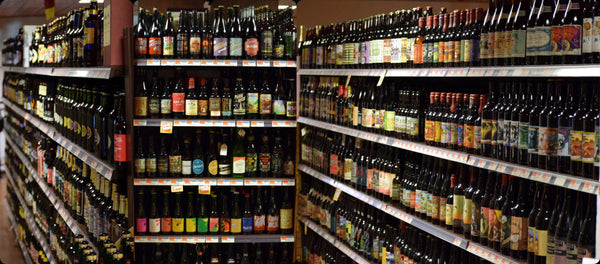Analysis Paralysis: Choosing a Craft Beer in the Digital Age
If you've ever stood in the store Googling beer reviews for 15 to 20 minutes, walking back and forth like some type of maniac, then you know exactly what it's like to be overloaded with choices and information.

But it's not just beer, it's everything. Have you looked for a new place to eat lately without checking out the Yelp and Google ratings? Or what about finding something to watch on Netflix without the support of Google, recommendations from friends on Facebook, and IMDB?
Analysis paralysis: it's the state of overthinking a situation to the point that no action is taken. In today's society, we not only have a sometimes infuriating amount of choices, we've also got all the information in the world at our fingertips. This can make it very difficult to make decisions.
Poll: Do you spend more time choosing a six-pack of #craftbeer or picking something to watch on #Netflix?
— box brew kits (@boxbrewkits) March 15, 2016
Google released a study recently that showed a woman who had 419 digital interactions before booking a trip to Disney World. 419! Between rating sites, online searches, and social recommendations, it doesn't seem like it'd be too hard to rack up a few dozen digital interactions before you check out with a six-pack.
How we've gotten to the point of analysis paralysis has been no mistake. Much has changed in both the world of beer and information in the past decade.
Growth in Variety and Availability of Craft Beer
The beer industry has gone through a huge transformation in recent years. Most millennials, and everyone born before them, have no problem imagining a simpler time for beer, because we lived through it. In the '90s, the variety of beers you saw (and snagged) was typically dependent on which major brand your dad and friends' dads liked to drink. And with "big beer" front and center in most liquor stores, it was hard to imagine opting for anything else.
And then, while many of us had come of age in the 2000s, everything started to change. The selection of beers at bars and stores went through a dramatic shift in quality and variety as the number of craft breweries went through the roof. Sure, we still drank Natty Light-esque beers in most scenarios during that time, but craft beer was now on the radar.
In the 2000s, awareness of the value of artisinal beers, coupled with more availability started to pique many beer lovers' interest--and that trend has only been accelerating since then. Millennials and older generations alike have an appreciation for "good" beer that was much more exclusive in the past.
The interest makes sense, since recent years have been an exciting time for drinkers as well as brewers. Late last year, Chief Economist at the Brewers Association, Bart Watson, reported that the U.S. brewery count reached record levels:
The U.S. has now reached a new record number of breweries: https://t.co/arkTv8JGcz pic.twitter.com/Yj2WhlXTjg
— Bart Watson (@BrewersStats) December 2, 2015
The Brewers Association also released a number of data points at the end of 2015 to accompany that news:
- Brewery openings now exceed two a day.
- Fifteen states are now home to more than 100 breweries: California, Washington, Colorado, Oregon, Michigan, New York, Pennsylvania, Illinois, Texas, Ohio, Florida, Virginia, North Carolina, Wisconsin, Indiana.
- Data shows that “locally made” is important to over half of craft beer buyers.
- Similarly, knowing that the beer is made by a small and independent brewery is important to a majority of craft drinkers in their purchase decision.
Not everyone sees growth in the industry as rosy. In fact, we've read a lot of articles recently from the opposite perspective. Fritz Hahn from The Washington Post chimed into the conversation in January:
"The expanding market — at least two breweries open every day — has created a new set of problems for brewers. New arrivals, riding the craft beer wave, are finding it difficult to stand out. And it’s not as if bars have doubled the number of their taps in the past five years. So not only do the new breweries need to squeeze past their rivals even to make it in front of consumers, but they might need to convince bars that they’re more deserving of a chance than better-known beers from Lagunitas or Great Lakes."
Joshua Bernstein from Bon Appetit also commented on the consumer side of things:
"I’m onboard with America abandoning middle-of-the-road beer and exploring flavorful new directions. The highway, however, is getting mighty crowded. Hundreds of different beers debut weekly, creating a scrum of session IPAs, spiced witbiers, and barrel-aged stouts scuffling for shelf space. For consumers, the situation is doubly confusing. How can you pick a pint on a 100-brew tap list? Moreover, beer shops are chockablock with pale this and imperial that, each one boasting a different hop pun. When buying beer, I can’t count how many times I’ve assisted overwhelmed shoppers, playing the benevolent Sherpa in the wilds of modern brewing."
The industry has rapidly grown and evolved, but how fast information spreads and how accessible it is today is worth discussing, as it's only enabled indecisiveness.
Selecting Beer in the Digital Age
Not all that long ago, data was hard to come by on the fly, and derivatives of that data (the ratings, reviews and instant feedback we've come to rely on) were an even rarer sight; we were often forced to take action based on the information we had readily at hand. But the web, and more recently mobility, has enabled us to accompany every decision with incredible due diligence anywhere, anytime.
Like Yelp for food and Rotten Tomatoes for movies and Glassdoor for employer ratings, new services and business models have emerged to provide beer drinkers with information on the right brews to choose. A few of our favorites include:
- BeerAdvocate: an incredibly popular beer magazine and beer rating website
-
Untappd: a mobile app that allows you to socially share the brew you'
re currently enjoying, as well as where you're enjoying it, with your friends - RateBeer: another great beer rating and review website
But as we mentioned, the ease of accessing information has been both a blessing and a curse.
If you're like us, selecting a beer has matured into selecting the right beer. With so many options and exciting new tastes and recipes, it can be hard to justify not putting in a little research on the fly. The challenge is to not lose your mind in the process.
How do you research beers? Is there a better way to make a selection? Let us know your thoughts on Twitter @boxbrewkits.


